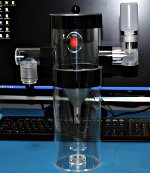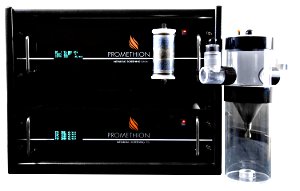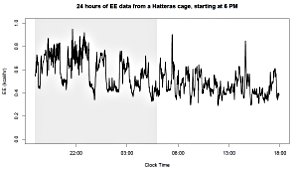Combining a metabolic cage (with urine and feces collection) and respirometry: It's easy!
 In some fields of research, a difficult balancing act exists between answering different questions. For example, a researcher may need to measure metabolic rates, while also needing quantitative measurements of urine and feces output. Measuring compounds in the urine is often key to understanding questions such as the biochemical pathways by which drugs are metabolized, or determining excreted nitrogen levels. The feces, though not quite as romantic (comparatively speaking) as the urine, are also important, especially when studying animal models of human conditions such as celiac disease or deriving energy expenditure via (input - output) calculations.
In some fields of research, a difficult balancing act exists between answering different questions. For example, a researcher may need to measure metabolic rates, while also needing quantitative measurements of urine and feces output. Measuring compounds in the urine is often key to understanding questions such as the biochemical pathways by which drugs are metabolized, or determining excreted nitrogen levels. The feces, though not quite as romantic (comparatively speaking) as the urine, are also important, especially when studying animal models of human conditions such as celiac disease or deriving energy expenditure via (input - output) calculations.
But here's the thing. Measuring urine and feces output accurately requires a special device known as a metabolic cage, which you can see to your left, posing dramatically as HAL. There's no getting around the fact that metabolic cages are unnatural and stressful environments for mice or rats. As a result, compared to home cages in which metabolic rates can be measured in relatively natural conditions, metabolic cages are certainly not an ideal compromise. You get accurate urine and feces output measurements, or you get unstressed metabolic rate measurements, take your pick. One of the two. It would be nice to be able to promise researchers some magic combination of the two, but as yet it doesn't exist because the two fundamental requirements are contradictory.
That said, it can be very useful to know what the real metabolic rate of a mouse in a metabolic cage actually is. Among other things, this tells you how the stress of being in a metabolic cage affects its metabolic rate. This is a useful index to discern just how stressed the animal actually is, and how representative your measurements are of animals in a natural state.
Here's a problem. Outmoded indirect calorimetry or metabolic phenotyping systems operate only in push mode, which absolutely requires totally sealing the habitat of the animal. Push mode is easy and cheap to implement, hence its popularity. But metabolic cages are extremely difficult to make airtight. And if a metabolic cage starts off being airtight, it is guaranteed not to stay that way. And, further, if a metabolic cage is to be used for push mode metabolic measurement, it must be specially manufactured for the purpose. And this unfortunately excludes the best-designed and most widely used metabolic cages.
With Sable Systems' Promethion, which is the only natively pull mode metabolic phenotyping system, it is trivial to convert practically any metabolic cages so that the metabolic rate of their inhabitants can be measured accurately and with excellent temporal resolution.
For years, I've been chatting with Richard Goodman of Hatteras Instruments at scientific conferences. Hatteras makes beautifully designed and widely used metabolic cages. It struck me that converting them to use pull mode respirometry would be very, very easy. Finally, Richard and I actually did something about our long-standing conversations, and he sent me a metabolic cage to evaluate for metabolic measurement using a Promethion metabolic phenotyping system.
 Here is the same Hatteras cage, sitting next to an 8-channel Promethion metabolic phenotyping system with a blazing fast 2-minute cycle time through all eight cages, independent of the length of tubing attached to each cage. Click the image to embiggen it. Because a pull system is used, the cage doesn't need to be sealed - in fact, it has to be somewhat open to the ambient environment. By using a solid rather than a perforated lid, and installing a tubing fitting in the lid, air was pulled from the top chamber in which the mouse lives via the small open spaces in the food and water dispensers, which are in the two arms to either side of the metabolic cage. The urine and feces collection device can be seen in the bottom half of the cage. This ingenious device separates urine and feces, allowing each to be independently collected. Hatteras also makes a refrigerated urine uptake collector if this is needed. In fact, Hatteras makes beautifully designed racks of 15 metabolic cages, which are just begging to be converted - so easily! - to allow simultaneous measurement of the metabolic rates of multiple animals via indirect calorimetry.
Here is the same Hatteras cage, sitting next to an 8-channel Promethion metabolic phenotyping system with a blazing fast 2-minute cycle time through all eight cages, independent of the length of tubing attached to each cage. Click the image to embiggen it. Because a pull system is used, the cage doesn't need to be sealed - in fact, it has to be somewhat open to the ambient environment. By using a solid rather than a perforated lid, and installing a tubing fitting in the lid, air was pulled from the top chamber in which the mouse lives via the small open spaces in the food and water dispensers, which are in the two arms to either side of the metabolic cage. The urine and feces collection device can be seen in the bottom half of the cage. This ingenious device separates urine and feces, allowing each to be independently collected. Hatteras also makes a refrigerated urine uptake collector if this is needed. In fact, Hatteras makes beautifully designed racks of 15 metabolic cages, which are just begging to be converted - so easily! - to allow simultaneous measurement of the metabolic rates of multiple animals via indirect calorimetry.
Of course, these are just words. How about some proof?
 Glad you asked! Here are 1000 words - 24 hours of beautifully detailed metabolic data, recorded from a mouse in a Hatteras instruments metabolic cage. You can see the nocturnal and diurnal activity cycles very clearly. Click on the image to enlarge it.
Glad you asked! Here are 1000 words - 24 hours of beautifully detailed metabolic data, recorded from a mouse in a Hatteras instruments metabolic cage. You can see the nocturnal and diurnal activity cycles very clearly. Click on the image to enlarge it.
There are two basic choices to be made when selecting a metabolic phenotyping system. One is whether the system operates in push or pull mode, and the other is the temporal resolution of the system.
To address the first point, no metabolic phenotyping system exists that can easily be reconfigured from push into pull mode or vice versa without compromising usability, accuracy or both. They are either natively push, or natively pull, from the ground up. Don't believe anyone who tells you otherwise. And as you can see, pull systems have enormous advantages, including very low stress home cage environments - and, of course, the ability to easily adapt a wide variety of other habitats, including metabolic cages, for metabolic measurement.
To address the second point, a multiplexed metabolic phenotyping system can serve the majority of research needs, provided its cycle time is sufficiently fast. Legacy metabolic phenotyping systems suffer from pitifully slow cycle times, anything from 15 to 45 minutes for cycling through 16 cages. Promethion-M systems, in contrast, boast cycle times down to two minutes, and maintain those cycle times irrespective of the lengths of tubing connecting the system to the cages (this is a major, major disadvantage in legacy systems, especially those that operate in push mode). If there is a need for even greater speed, such as for fast drug pharmacokinetic studies, Promethion-C systems dedicate a complete gas analysis chain to each cage, and have a temporal resolution of just one second for all cages.
Either of these Promethion systems can be used with home cages outfitted for food and water uptake, body mass, running wheel, position and activity detection, and more - or, completely interchangeably, with metabolic cages, such as those from Hatteras Instruments. The same system can be used for either. It's your decision, based on your research priorities for a particular scientific question. And you always have our expert Ph.D.-level technical and scientific support to rely on, "By Scientists, For Scientists".
If you have any questions, feel free to contact me!
- Log in to post comments